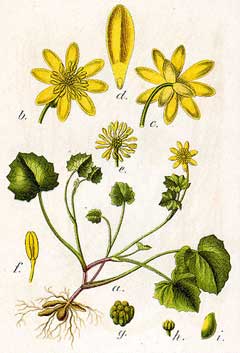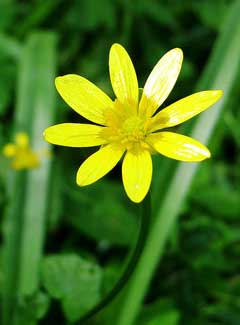 |
|
http://commons.wikimedia.org/wiki/File:Ranunculus_ficaria_Sturm59.jpg |
 |
| © Andrew Dunn, http://www.andrewdunnphoto.com/ |
Translate this page:
Summary
UPDATE 11/4/2012: Ranunculus ficaria L. is a synonym of Ficaria verna Huds.
Physical Characteristics

 Ranunculus ficaria is a PERENNIAL growing to 0.2 m (0ft 8in) by 0.2 m (0ft 8in) at a fast rate.
Ranunculus ficaria is a PERENNIAL growing to 0.2 m (0ft 8in) by 0.2 m (0ft 8in) at a fast rate.
It is not frost tender. It is in leaf from January to June, in flower from March to May. The species is hermaphrodite (has both male and female organs) and is pollinated by Bees, flies, beetles.
Suitable for: light (sandy), medium (loamy) and heavy (clay) soils. Suitable pH: mildly acid, neutral and basic (mildly alkaline) soils. It can grow in semi-shade (light woodland) or no shade. It prefers moist soil.
UK Hardiness Map
US Hardiness Map
Synonyms
Ficaria verna. F. ranunculoides.
Plant Habitats
Woodland Garden Dappled Shade; Shady Edge; Ground Cover; Meadow;
Edible Uses
Edible Parts: Leaves Root
Edible Uses: Condiment
Young leaves in spring - raw or cooked as a potherb[2, 74, 105, 183]. The first leaves in spring make an excellent salad[9]. The leaves, stalks and buds can be used like spinach[9], whilst the blanched stems are also eaten[46, 183]. The leaves turn poisonous as the fruit matures[74]. Caution is advised regarding the use of this plant for food, see the notes above on toxicity. Bulbils - cooked and used as a vegetable[9, 105]. The bulbils are formed at the leaf axils and also at the roots[9, 183]. Caution is advised, see the notes above on toxicity. The flower buds make a good substitute for capers[183].
References More on Edible Uses
Medicinal Uses
Plants For A Future can not take any responsibility for any adverse effects from the use of plants. Always seek advice from a professional before using a plant medicinally.
Antirheumatic Astringent Vitamin C
Lesser celandine has been used for thousands of years in the treatment of haemorrhoids and ulcers[254]. It is not recommended for internal use because it contains several toxic components[254]. The whole plant, including the roots, is astringent[4, 165, 238]. It is harvested when flowering in March and April and dried for later use[4]. It is widely used as a remedy for piles and is considered almost a specific[4, 238]. An infusion can be taken internally or it can be made into an ointment and used externally[4, 238]. It is also applied externally to perineal damage after childbirth[238]. Some caution is advised because it can cause irritation to sensitive skins[244].
References More on Medicinal Uses
The Bookshop: Edible Plant Books
Our Latest books on Perennial Plants For Food Forests and Permaculture Gardens in paperback or digital formats.

Edible Tropical Plants
Food Forest Plants for Hotter Conditions: 250+ Plants For Tropical Food Forests & Permaculture Gardens.
More

Edible Temperate Plants
Plants for Your Food Forest: 500 Plants for Temperate Food Forests & Permaculture Gardens.
More

More Books
PFAF have eight books available in paperback and digital formats. Browse the shop for more information.
Shop Now
Other Uses
Teeth
The flower petals are an effective tooth cleaner[60]. ( See notes at top of the page before using the petals) The plant often forms dense carpets when grown in the shade and can therefore be used as a ground cover though they die down in early summer. This should be done with some caution, however, since the plant can easily become an unwanted and aggressive weed in the garden[K].
Special Uses
Ground cover
References More on Other Uses
Cultivation details
Prefers a moist loamy neutral to alkaline soil in full sun or shade[1, 238]. A very common and invasive weed[17, 90], especially when growing in the shade because this encourages formation of bulbils at the leaf bases[238]. You would regret introducing it into your garden, though it might have a place in the wild garden[90]. This is, however, a polymorphic species[90] and there are a number of named forms selected for their ornamental value[188]. These are normally less invasive than the type species. The plant flowers early in the year when there are few pollinating insects and so seed is not freely produced[4]. The plant, however, produced tubercles (small tubers) along the stems and each of these can grow into a new plant[4]. Grows well along woodland edges[24], and in the deeper shade of the woodland where it often forms dense carpets[4]. The flowers do not open in dull weather and even on sunny days do not open before about 9 o'clock in the morning and are closed by 5 o'clock in the evening[4]. A greedy plant, inhibiting the growth of nearby plants, especially legumes[54].
References Carbon Farming Information and Carbon Sequestration Information
Temperature Converter
Type a value in the Celsius field to convert the value to Fahrenheit:
Fahrenheit:
The PFAF Bookshop
Plants For A Future have a number of books available in paperback and digital form. Book titles include Edible Plants, Edible Perennials, Edible Trees,Edible Shrubs, Woodland Gardening, and Temperate Food Forest Plants. Our new book is Food Forest Plants For Hotter Conditions (Tropical and Sub-Tropical).
Shop Now
Plant Propagation
Seed - sow spring in a cold frame. This species doesn't really need any help from us. Division in spring.
Other Names
If available other names are mentioned here
Native Range
TEMPERATE ASIA: Cyprus, Israel, Jordan, Lebanon, Syria, Turkey, Russian Federation-Ciscaucasia (Ciscaucasia), Georgia, Russian Federation-Western Siberia (Western Siberia (southwest)) EUROPE: Denmark, Finland (south), United Kingdom, Ireland, Norway, Sweden (south), Austria, Switzerland, Czech Republic, Germany, Hungary, Poland, Slovakia, Russian Federation (European part), Belarus, Estonia, Lithuania, Latvia, Ukraine (incl. Krym), Albania, Bulgaria, Bosnia and Herzegovina, Greece (incl. Crete), Croatia, Italy (incl. Sardinia, Sicily), North Macedonia, Montenegro, Romania, Serbia, Slovenia, Spain (incl. Baleares), France (incl. Corsica), Portugal AFRICA: Algeria (north), Libya (north), Morocco, Tunisia
Weed Potential
Right plant wrong place. We are currently updating this section.
Please note that a plant may be invasive in one area but may not in your area so it's worth checking.
Conservation Status
IUCN Red List of Threatened Plants Status :

| Related Plants
|
| Latin Name | Common Name | Habit | Height | Hardiness | Growth | Soil | Shade | Moisture | Edible | Medicinal | Other |
| Ranunculus acris | Meadow Buttercup, Tall buttercup, Showy buttercup | Perennial | 1.0 |
0-0
| | LMH | SN | MWe | 1 | 2 | 0 |
| Ranunculus aquatilis | Water Crowfoot, White water crowfoot | Annual/Perennial | 0.0 |
4-8
| | LMH | SN | MWeWa | 1 | 1 | |
| Ranunculus arvensis | Corn Buttercup | Annual | 0.5 |
0-0
| | LMH | SN | M | 0 | 1 | 0 |
| Ranunculus bulbosus | Bulbous Buttercup, St. Anthony's turnip | Perennial | 0.3 |
0-0
| F | LMH | SN | M | 1 | 2 | 0 |
| Ranunculus californicus | California Buttercup | Perennial | 0.6 |
6-9
| | LMH | SN | M | 1 | 0 | |
| Ranunculus chinensis | Hui Hui Suan | Perennial | 0.6 |
-
| | LMH | SN | MWe | 1 | 0 | |
| Ranunculus flammula | Lesser Spearwort, Greater creeping spearwort | Perennial | 0.6 |
4-8
| | LMH | SN | MWeWa | 0 | 1 | |
| Ranunculus hirtus | | Perennial | 0.0 |
-
| | LMH | SN | M | 0 | 1 | |
| Ranunculus inamoeus | Graceful Buttercup | Perennial | 0.3 |
-
| | LMH | SN | M | 1 | 0 | |
| Ranunculus japonicus | Mao Gen | Perennial | 0.1 |
-
| | LMH | SN | M | 1 | 1 | |
| Ranunculus kochii | | Perennial | 0.1 |
5-9
| | LMH | N | M | 1 | 0 | |
| Ranunculus muricatus | Rough-Seed Buttercup, Spinyfruit buttercup | Annual | 0.3 |
0-0
| | LMH | SN | M | 0 | 1 | |
| Ranunculus nipponicus | | Perennial | 0.0 |
-
| | LMH | SN | WeWa | 1 | 0 | |
| Ranunculus occidentalis | Western Buttercup | Perennial | 0.6 |
-
| | LMH | SN | M | 1 | 0 | |
| Ranunculus pallasii | Buttercup, Pallas' buttercup | Perennial | 0.1 |
0-0
| | LMH | SN | MWe | 1 | 0 | |
| Ranunculus pennsylvanicus | Pennsylvania Buttercup | Annual/Perennial | 1.0 |
-
| | LMH | SN | MWe | 1 | 1 | 2 |
| Ranunculus quelpaertensis | | Perennial | 0.6 |
-
| | LMH | SN | MWe | 1 | 0 | |
| Ranunculus repens | Creeping Buttercup, Prairie Double-flowered Buttercup, Water Buttercup, Creeping Buttercup | Perennial | 0.3 |
3-8
| F | LMH | SN | M | 1 | 1 | 0 |
| Ranunculus reptans | Creeping Spearwort | Perennial | 0.2 |
-
| F | LMH | SN | MWe | 1 | 0 | |
| Ranunculus rivularis | | Perennial | 0.0 |
-
| | LMH | SN | M | 0 | 1 | |
| Ranunculus sceleratus | Celery-Leaved Buttercup, Cursed buttercup | Perennial | 0.6 |
0-0
| | LMH | SN | MWeWa | 1 | 1 | 1 |
| Ranunculus tachreoi | | Perennial | 1.0 |
-
| | LMH | SN | M | 1 | 0 | |
| Ranunculus ternatus | | Perennial | 0.3 |
-
| | LMH | SN | M | 0 | 1 | |
|
Growth: S = slow M = medium F = fast. Soil: L = light (sandy) M = medium H = heavy (clay). pH: A = acid N = neutral B = basic (alkaline). Shade: F = full shade S = semi-shade N = no shade. Moisture: D = dry M = Moist We = wet Wa = water.
Now available:
Food Forest Plants for Mediterranean Conditions
350+ Perennial Plants For Mediterranean and Drier Food Forests and Permaculture Gardens.
[Paperback and eBook]
This is the third in Plants For A Future's series of plant guides for food forests tailored to
specific climate zones. Following volumes on temperate and tropical ecosystems, this book focuses
on species suited to Mediterranean conditions—regions with hot, dry summers and cool, wet winters,
often facing the added challenge of climate change.
Read More
Expert comment
Author
L.
Botanical References
17
Links / References
For a list of references used on this page please go here
Readers comment